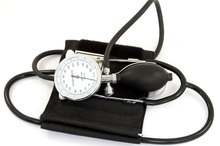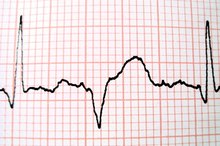How to Read an Echocardiogram
An echocardiogram is a medical test using sound waves to construct a moving picture of the heart. A transducer is used in performing an echocardiogram by sending out high-frequency sound waves and transmitting the echoes of the signals into electrical impulses. This test is used to check heart chambers and valves, allowing doctors to diagnose the movement of the heart. Murmurs, valve beats and the pumping efficiency of the heart is then monitored.
Examine the echocardiogram results. The first section of the result shows the intracardiac dimensions of the heart. The acronyms refer to the different structures of the heart being measured. IVSd is the intervernicular septum in diastole, and refers to the wall linking the ventricles of the heart. LVIDd means left ventricular internal diameter in diastole, referring to the left ventricular internal diameter in systole. LVPWd is the lfeft ventricle posterior wall in diastole.
Instructions for How to Calibrate a Sphygmomanometer
Learn More
Compare ranges for heart structures. Use a table of values for the normal range of the different structures of the heart and compare the results of the echocardiogram determine if the test falls within range.
Consult the report on the size of the left and right ventricles to see if it is small, normal or dilated. Each size classification is associated with different medical conditions. The right ventricle is about 2/3 the size of the left ventricle. If the results show that these are similar in size, a significant condition is present in the right ventricle and must be treated.
How to Read an EKG for Dummies
Learn More
Check the results for the atria to determine if it’s normal or dilated. A dilated atria can indicate a diastolic dysfunction and relates to the heart's stiffness.
Find the results for the different valves. The mitral valve is measured to check for stenosis or narrowing of the passageway. Mitral regurgitation refers to the backward flow of blood in the mitral valve with each contraction of the left ventricle. Severe regurgitation results indicate that the patient is experiencing shortness of breath due to a damaged heart valve and may need to undergo surgery. Look at the results for the tricuspid valve; backward blood flow is common here. For severe tricuspid regurgitation, the comments section of the echocardiogram report on the condition of the right ventricle provides information.
Study reports on stenosis and regurgitation in the aortic valve. Moderate stenosis must not be underestimated and must be treated, as it is potentially severe. For aortic regurgitation, determine if the regurgitation is mild or not, as the latter typically requires surgery.
Review the result for the pulmonic valve. Stenosis is very rare as is the occurrence of moderate and severe regurgitation. The cause must be traced if these findings are present.
Tips
Identify abnormal test result sections. Consult with a cardiologist for diagnosis and better understanding of the results. Always seek the advice of a cardiologist before attempting self-diagnosis and treatment.









